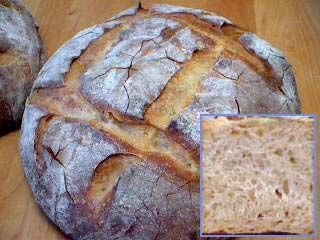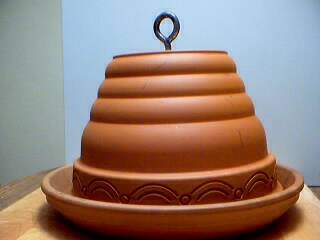
Carl Griffith's 1847 Oregon Trail Sourdough Starter
This photo was submitted by "Carlos":

So we asked him some questions:
Q. Carlos, how did you make this fine loaf?
A. If there is any secret to making the bread, it is to use well-activated Carl's culture. The recipe for these particular loaves is Reinhart's S. F. Sourdough from his Crust and Crumb book. The process is to make a firm starter from active 100% hydration start culture and additional flour. You let the firm starter double and then retard it for one to three days. Then you make up a fairly firm dough and ferment it for six hours. Then you make up the loaves and retard them at least overnight. I find that I should retard the dough right after shaping or the dough will over proof in the refrigerator.
Q. Wow, a fine looking loaf like that must be really tasty.
A. I do usually get nice looking bread from this process, but I have to be honest, it doesn't taste any better than the pan bread, which is a lot easier to make. This particular batch I baked in my poor man's cloche. I did that because the dough was just slightly over proofed. That called for a hot oven to start. By baking in the cloche, I did not have to open the oven door to toss in water for steam and thus lose oven temperature.
Q. Can you tell us a bit more about your cloche?
A. Well, here is a picture. It is just a terra cotta flower pot and tray. I made the handle from an eyebolt, two nuts, soup can ends, and some washers.

Most of the time I use just the terra cotta tray, which is almost 14 inches in diameter, as a baking stone without the top. I use a pizza stone on the oven shelf above the bread instead of the flowerpot top. I have to throw water into the cast iron pan on the bottom of the oven for steam, but I don't have to handle a 500 degrees flowerpot. When I want to bake two loaves at a time, I turn the tray upside-down to get a flat surface up so I can use a half sheet pan for a baking surface. If I lose anything doing it that way, it is not much.
Q. How do you know the cloche gets to 500 degrees?
A. It doesn't. But it does get hot. I preheat the oven to 500 degrees on the dial. It actually is a fair amount less than that and I don't leave it there long enough for everything in the oven to equalize at the high temp. You can put the dough into a non-heated cloche, but the crust doesn't get as nice. You can preheat just the bottom and get almost the full effect. However, if you are going to preheat the bottom, you might as well do the whole thing.
Q. Do you suppose it could all be done without the retards?
A. Sure. However, you do need to retard the shaped loaves at least six to eight hours to get the little blisters on the crust and the red tone to the color of the crust. Neither shows up very well on the picture. I come back to this recipe from time to time, because it so far has me beat. Reinhart won some national contest with this, and others, Janet Bostwick, for one, wax poetic over the flavor of this bread. So far the contest-winning flavor eludes me. It is very good, but no better than the pan bread at the CarlsFriends web site.
Q. I notice your name is Carlos. Could I assume that you have Hispanic roots?
A. Actually, my name is Charles Perry…but I am studying Spanish.
Q. Adiós, Sr. Carlos, y mucho gracias.
23FEB2002
Carlos reports that he has been inspired by Iggy's Francese Sourdough and has set out to reproduce it, within reasonable bounds. He has submitted this graphic, representing early work, in evidence of his commitment:

A recipe has been found, but is not necessarily approved by Iggy. This attempt modified that recipe by using Carl's starter, two teaspoons of salt, and 16 Oz. of bread flour.
Keep your eye on this space for further developments.
7MAR2002